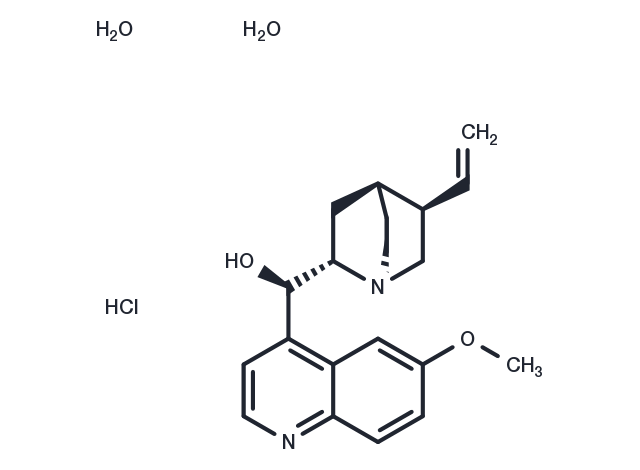Powder: -20°C for 3 years | In solvent: -80°C for 1 year


Quinine hydrochloride dihydrate (Quinine HCl Dihydrate) is a white crystalline K+ channel blocker, used to treat malaria.

| Pack Size | Availability | Price/USD | Quantity |
|---|---|---|---|
| 1 g | In stock | $ 29.00 | |
| 1 mL * 10 mM (in DMSO) | In stock | $ 30.00 |


| Description | Quinine hydrochloride dihydrate (Quinine HCl Dihydrate) is a white crystalline K+ channel blocker, used to treat malaria. |
| In vitro | Quinine blocks Cx36 and Cx50 junctional currents in a reversible and concentration-dependent manner with half maximal blocking concentrations of 32 mM and 73 mM, respectively. Quinine induces slow transitions between open and fully closed states that decreased open probability of the channel. Quinine thus offers a potentially useful method to block certain types of gap junction channels, including those between neurons that are formed by Cx36. [1] Quinine, a K+ channel blocker, prevents formation of tumor necrosis factor (TNF) as well as the subsequent hepatic DNA fragmentation and liver enzyme leakage. [2] Quinine elicits Fos-like immunoreactivity (FLI) concentrated in the medial third of the nucleus; acid elicited more broadly distributed FLI concentrated farther laterally. [3] Quinine has a relatively weak effect on doxorubicin accumulation but was able to completely restore doxorubicin sensitivity in the resistant cells. Quinine also modifies the intracellular tolerance to doxorubicin, which suggests that it is able to modify drug distribution within the cells. [4] Quinine primarily blocks the whole cell potassium currents (IK) in a voltage-dependent manner. Quinine also reduces the size of sodium currents (INa) in a use-dependent manner, while leaving calcium currents (ICa) relatively unaffected. [5] |
| Synonyms | Quinine HCl Dihydrate |
| Molecular Weight | 396.91 |
| Formula | C20H24N2O2·HCl·2H2O |
| CAS No. | 6119-47-7 |
Powder: -20°C for 3 years | In solvent: -80°C for 1 year
DMSO: 79 mg/mL (199.03 mM)
Ethanol: 79 mg/mL (199.03 mM)
H2O: 43 mg/mL (108.33 mM)
You can also refer to dose conversion for different animals. More
bottom
Please see Inhibitor Handling Instructions for more frequently ask questions. Topics include: how to prepare stock solutions, how to store products, and cautions on cell-based assays & animal experiments, etc.
Quinine hydrochloride dihydrate 6119-47-7 Membrane transporter/Ion channel Microbiology/Virology Parasite Potassium Channel Quinine Hydrochloride Quinine HCl inhibit anti-malarial cinchonaine Inhibitor Quinine hydrochloride Dihydrate Quinine Quinine HCl Dihydrate KcsA inhibitor
